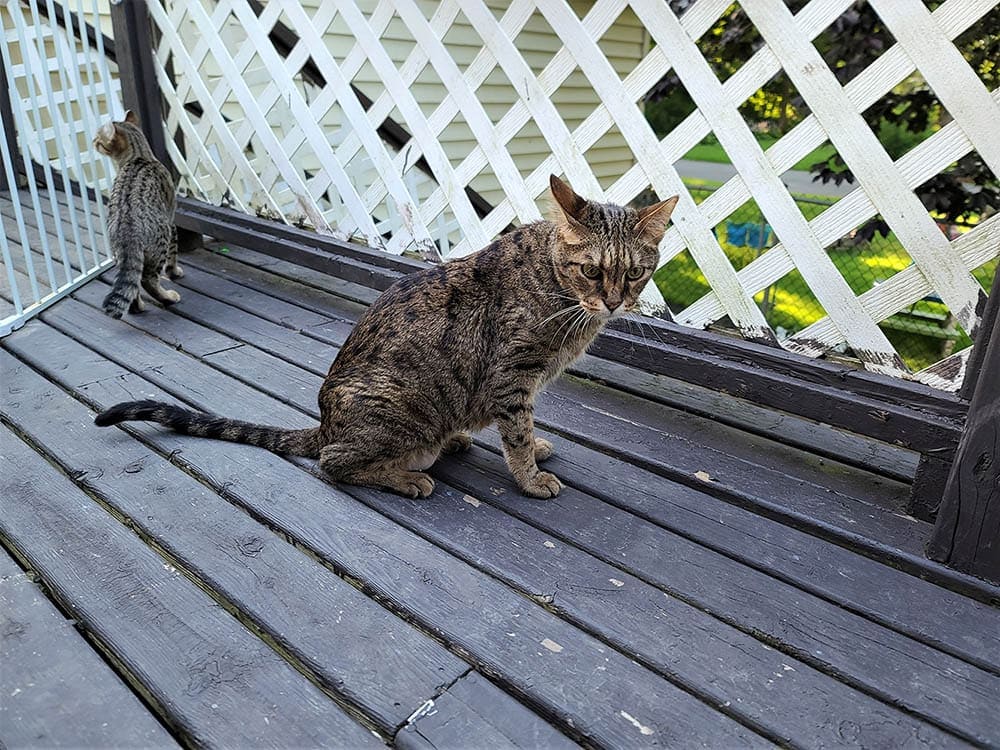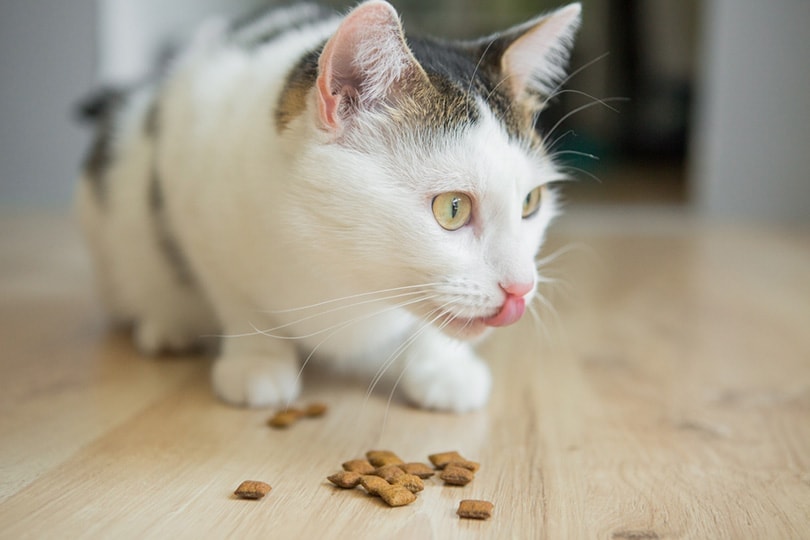Cats can be curious, which may make the use of some type of gate or barrier necessary to protect your cat, other pets, plants, or home. However, cats can also be sneaky and difficult to contain, which can make it nearly impossible to find a barrier that contains your cat.
If your cat is regularly sneaking into places they don’t belong, you’re in luck. There are multiple barriers and gates you can DIY at home today, sometimes even with items you already have on hand. Keep reading for some easy and affordable plans for cat gates and barriers.
The 8 Best DIY Cat Gate and Barrier Plans –
1. Wire Shelf Barrier
| Supplies needed: | Wire shelves (3), zip ties or cable ties, scissors |
| Skill level: | Easy to moderate |
| Escape proof?: | 3/5 |
This cat barrier is easy and affordable to make and requires minimal technical know-how to create. The best part is that they allow you to safely block your cat out of an area without having to shut the door.
Wire shelves come pre-cut at around 4 feet in length, but some home improvement stores will also cut these shelves to size if needed. They should be about 16 inches wide and have a small lip to help them fit together better.
-
Special Considerations
This barrier can be extremely easy to create, but it may require additional knowledge if you plan to attach the barrier in a semi-permanent fashion. This can be done with something as simple as Velcro or Command Strips or something as complicated as wall anchors.
The more securely this barrier is anchored, the more escape-proof it will be. If you simply prop the barrier up in a doorway or use shelves that are shorter than the height of the door, a committed cat will easily find a way around the barrier.
2. Cat Fence Doorway
| Supplies needed: | 1”x1” wood (4 pieces), adjustable hardware, cat fencing, or hardware cloth |
| Skill level: | Moderate to hard |
| Escape proof?: | 5/5 |
If you have a doorway that isn’t used frequently, this is a great option. This barrier provides airflow and a view to the other side of the door, making it a good option for doors that lead outside.
This cat barrier does require accurate measurements and wood cuts. If you can get accurate measurements, the staff at most home improvement stores should be able to cut the wood to meet your needs. Measure the interior of the doorway, and it’s a good idea to draw out what the length of each wood cut should be.
-
Special Considerations
Choose hardware for this door that can be removed as needed. It is not ideal for daily use, but you should not install this barrier in such a way that it permanently closes off a space. Whether for safety, cleaning, or convenience, you should not permanently install this type of barrier in most situations.
3. Extra Large Lattice Cat Gate
| Supplies needed: | 4’x8’ vinyl lattice (3), lattice caps (12), screws, zip ties |
| Skill level: | Moderate to hard |
| Escape proof?: | 3/5 |
This extra-large cat gate is ideal for cats that can’t or won’t jump more than about 4 feet. You’ll be cutting (or paying someone to cut) the lattice pieces in half, leaving you with six 4’x4’ pieces. You can, however, make it as tall or as short as you’d like.
This is a fantastic option if you have a large space that most pet and baby gates and barriers won’t fit. If made as instructed, this ends up being around 20 feet long. It won’t allow your cat under or around it if attached to the walls at both ends of the open space.
-
Special Considerations
Although you can DIY this barrier in an afternoon, it is a multi-step process that requires power tools and technical knowledge. You’ll need access to a power drill, clamps, and a saw to create this cat gate. While most home improvement stores will cut your pieces for you, they’re not likely to help you put everything together.
4. Baby Crib Cat Gate
| Supplies needed: | Baby crib frame, hinges (2), door latch, spray paint (optional) |
| Skill level: | Moderate |
| Escape proof?: | 3/5 |
Whether you have an old baby crib in your attic or a local “buy-nothing” group, you can get an old baby crib for free or for a minimal expense. To make this cat gate, you’ll need a piece of a crib’s frame that fits the width of your door, so some cutting may be necessary when dealing with unusual doorway or crib sizes.
This cat barrier isn’t going to keep kittens or small cats contained, but it is a good option for large cats or cats that aren’t going to attempt to squeeze between the slats or jump the gate.
-
Special Considerations
If cutting the crib’s frame is necessary to fit your space, an electric saw will be necessary. You’ll need some knowledge of how to cap or otherwise cover the cut ends to protect your cat from accidental injury on sharp edges. You’ll also need a power drill to install the hinges and door latch.
5. Spare Wood Cat Gate
| Supplies needed: | 2”x4” wood, hinges (2), door latch |
| Skill level: | Moderate |
| Escape proof?: | 5/5 |
This cat gate is easy and inexpensive to make and can be made with whatever scrap wood you have lying around in your garage. Ideally, any rough wood should be sanded smooth before use to prevent splinters and scrapes.
This cat gate looks like the baby crib cat gate, but the width between the slats and the overall height and size of the gate is fully customizable. For someone experienced in measuring and cutting wood, as well as simple installations, like hinges, this gate can be made and installed in under an hour.
-
Special Considerations
Unless you have spare wood that is already the correct size for your space, you’ll need access to an electric saw. You’ll also need a power drill to install the hinges and the door latch.
If you’re concerned about your cat jumping this gate, you can adjust the height to suit your needs. If you install the slats horizontally, you’ll give your cat a foothold, so plan to install them vertically to prevent climbing.
6. Lattice and Pool Noodle Cat Barrier
| Supplies needed: | 4’x8’ vinyl lattice, pool noodle (2), adhesive or nails, box cutter |
| Skill level: | Easy |
| Escape proof?: | 3/5 |
This just might be the fastest DIY on the list! You can cut the vinyl to fit your space or have it cut for you at the home improvement store. The list of adhesives and products you can use to adhere the pool noodles to the wall or door frame is highly variable based on your preference. Velcro, Command Strips, superglue, and nails are all valid options for installing this cat barrier.
-
Special Considerations
Vinyl lattice is not particularly sturdy, so if your cat is insistent on being on the other side of this barrier, they might end up there! This is a good option for cats that won’t fight to get to the other side of a barrier.
7. PVC Pipe Cat Gate
| Supplies needed: | 1” PVC pipe (4), PVC T-connector (4), zip ties or cable ties, cat fencing or hardware cloth, tension rod (2) |
| Skill level: | Moderate |
| Escape proof?: | 3/5 |
PVC pipes are inexpensive and lightweight, making them ideal for many types of DIY projects. This gate operates like a baby gate but costs a fraction of the price. You can put it together in under an hour, and it doesn’t require any installation or wall damage.
You can customize these instructions to fit your needs. The height and materials can be adjusted to keep your cat securely on one side of the barrier. You can even customize this to be oversized for large spaces, assuming you can find tension rods to fit!
-
Special Considerations
Unless you’re lucky enough to have pre-cut PVC that fits perfectly on hand, you’ll need to cut the PVC to fit or have someone at the home improvement store do it for you.
To add to the security of this cat gate, you can adhere the PVC T-connectors to the PVC pipe with super-glue or another strong adhesive. Make sure you securely install the hardware cloth to the frame to keep your cat from finding weak spots and slipping out.
8. Fabric Cat Gate
| Supplies needed: | Thick fabric or blanket, fabric loop (4), wall hook (4) |
| Skill level: | Easy to moderate |
| Escape proof?: | 5/5 |
This fabric cat gate can be customized to fit your space, as well as your home décor and personal tastes. All you need is a handful of common household items, although you may need to make a trip to the store to purchase wall hooks. Command-style wall hooks are a great option since you can easily uninstall them.
This DIY project makes good use of an extra blanket or scrap fabric you may have in your home. This is an especially good DIY project for quilters and other crafters who are often left with extra fabric.
-
Special Considerations
To attach the fabric loops to the large fabric piece, you’ll need a little bit of basic sewing knowledge or knowledge of other ways to attach the loops to the fabric securely. You could do this with large safety pins, but they won’t be as aesthetically pleasing as sewing the fabric together.
Conclusion
Whether you’re short on time, patience, or funds, there’s an option here to meet your needs. Not all DIY cat gates and barriers are created equal, so make sure to choose one that you feel will suit your cat’s curiosity and commitment level. Some cats are dedicated to mischief, so you may find it challenging to create the perfect DIY barrier to keep your cat secure. However, with trial and error, you’ll quickly identify weak spots in your project and be able to adjust things as you need.
Featured Image Credit: Patrick Hatt, Shutterstock






